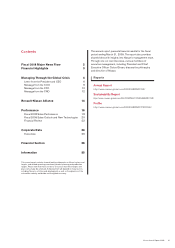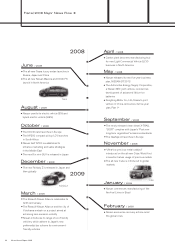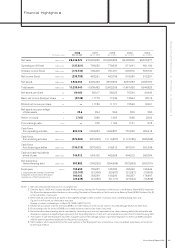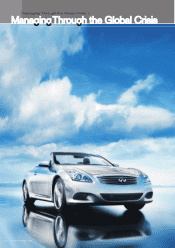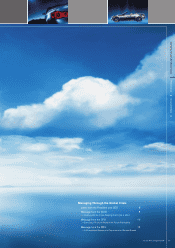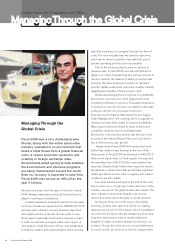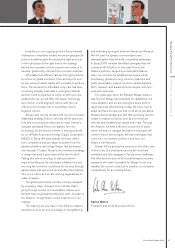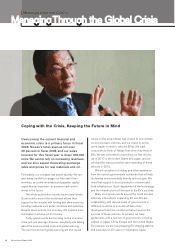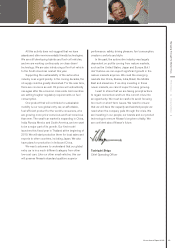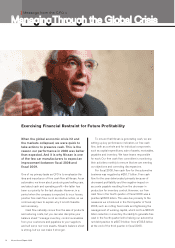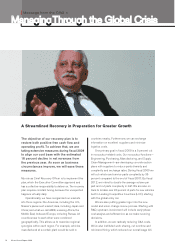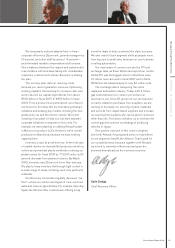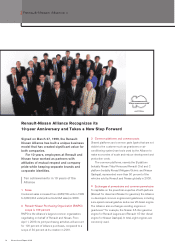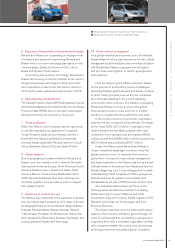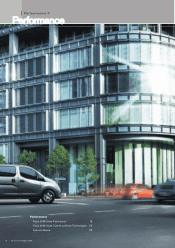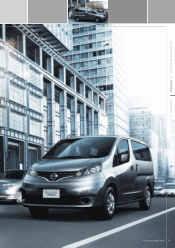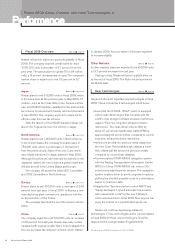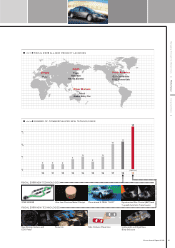Nissan 2009 Annual Report Download - page 13
Download and view the complete annual report
Please find page 13 of the 2009 Nissan annual report below. You can navigate through the pages in the report by either clicking on the pages listed below, or by using the keyword search tool below to find specific information within the annual report.
There are some positive signs for fiscal 2009, such
as better liquidity and a little stabilization in consumer
demand but we are not out of the dark yet.
Unemployment is still rising, oil prices are higher,
interest rates could go up, and almost halfway through
the calendar year we have not seen much of an auto
market recovery.
Governments worldwide have realized the depth of
this crisis, so they are creating incentives to promote
demand, including tax and cash incentives for consumers
switching to more fuel-efficient cars and funding for
the development of emission-free vehicles. In addition,
they are setting up mechanisms to facilitate borrowing.
It’s easier to borrow than it was at the end of 2008.
Europe is developing direct loans for the industry and
loans to develop projects. The various authorities in
Japan are also proposing different funding possibilities
for the auto industry. The U.S. is offering special
government-supported funding to promote sales
financing, such as Term Asset-Backed Securities Loan
Facility (TALF).
We used to borrow globally at a small spread over
interbank rates, or even below, and suddenly spreads
surged in fiscal 2008. In Europe, for example, spreads
for three-year money went up from less than 1 percent
to 6-7 percent in the last quarter of fiscal 2008. And
unless you were ready to pay such premiums, you could
not issue bonds. Fortunately we had alternative sources
of funding. Spreads are now coming down and markets
are progressively improving. But my focus is to keep
everyone cash-conscious. We know the market is
volatile, and we take nothing for granted. We are
diversifying our funding base, extending our maturities
and building up our cash position. We have important
confirmed lines of credit we can draw on, if necessary.
This includes nearly $3.8 billion of unused term facilities,
and nearly $3 billion in short-term backup lines. We
keep all of these in reserve as a collective safety net.
In fiscal 2009, we want to achieve a positive free
cash flow. We continue to put pressure on fixed costs
and will maintain the painful but necessary reduction
on wages until there is a recovery. To save on capital
expenditures, which are now lower than depreciation,
we have postponed the development of certain new
models, and decreased the number of new launches
from 60 to 48 during fiscal 2008 to 2012. We decided,
however, to keep a significant level of R&D expenses
for new technologies and new
products that are
necessary to match future consumer
demand, such as
the electric vehicles we intend to mass-produce and
our new global entry cars, which will be manufactured
in 5 different countries.
In addition, controlled levels of accounts payable,
which should improve from the increase in production
at the end of the year, as well as some asset sales will
help us achieve our free cash flow target.
Nissan’s core financial policy has long included
delivering a healthy dividend to shareholders.
Unfortunately, the crisis forced us to cut the dividend
and focus on preserving cash and maintaining operating
flexibility. Achieving positive free cash flow is key
improving our performance and revisiting our dividend
policy.
Finally, I want to stress the importance of the
Alliance with Renault, which is a major asset for our
company. We recently set up a common dedicated
team to make sure that every department of both
companies—from Powertrains to Platforms to
Manufacturing and from Research and Advanced
Engineering to Logistics to IS/IT and to Purchasing
—systematically extract all possible synergies. This
new “turbo process”applied to the Alliance should give
us a unique competitive advantage to increase our
capacity to invest in future growth while improving our
free cash flow.
Alain Dassas
Chief Financial Officer
Nissan Annual Report 2009 11
Managing Through the Global Crisis Performance Corporate Data


